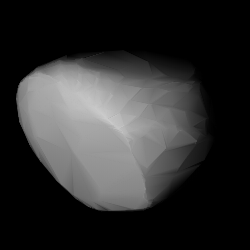
1036 Ganymed, provisional designation 1924 TD, is a stony asteroid on a highly eccentric orbit, classified as a near-Earth object of the Amor group. It was discovered by German astronomer Walter Baade at the Bergedorf Observatory in Hamburg on 23 October 1924, and named after Ganymede from Greek mythology. With a diameter of approximately 35 kilometers, Ganymed is the largest of all near-Earth objects but does not cross Earth's orbit. The S-type asteroid has a rotation period of 10.3 hours. In October 2024, it is predicted to approach Earth at a distance of 56,000,000 km; 35,000,000 mi (0.374097 AU).
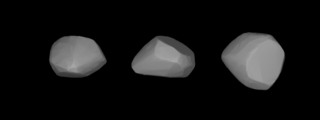
Niobe is a stony Gallia asteroid and relatively slow rotator from the central regions of the asteroid belt, approximately 90 kilometers in diameter. It was discovered by the German astronomer Robert Luther on 13 August 1861, and named after Niobe, a character in Greek mythology. In 1861, the brightness of this asteroid was shown to vary by astronomer Friedrich Tietjen.

Aegle is a carbonaceous asteroid and the namesake of the Aegle family located in the outer regions of the asteroid belt, approximately 170 kilometers in diameter. It was discovered on 17 February 1868, by French astronomer Jérôme Coggia at the Marseille Observatory in southeastern France. The rare T-type asteroid has a rotation period of 13.8 hours and has been observed several times during occultation events. It was named after Aegle ("brightness"), one of the Hesperides from Greek mythology.

Camilla is one of the largest asteroids from the outermost edge of the asteroid belt, approximately 250 kilometers in diameter. It is a member of the Sylvia family and located within the Cybele group. It was discovered on 17 November 1868, by English astronomer Norman Pogson at Madras Observatory, India, and named after Camilla, Queen of the Volsci in Roman mythology. The X-type asteroid is a rare trinary asteroid with two minor-planet moons discovered in 2001 and 2016, respectively. It is elongated in shape and has a short rotation period of 4.8 hours.

Belisana is a stony background asteroid from the inner regions of the asteroid belt, approximately 38 kilometers in diameter. It was discovered on 6 November 1877, by Austrian astronomer Johann Palisa at the Austrian Naval Observatory in today's Croatia. The S-type asteroid has a rotation period of 12.32 hours and a rather spherical shape. It was named after the Celtic goddess Belisama (Belisana).

Elsa is a Massalia or background asteroid from the inner regions of the asteroid belt, approximately 44 kilometers in diameter. It was discovered on 7 February 1878, by Austrian astronomer Johann Palisa at the Austrian Naval Observatory in today's Croatia. The S-type asteroid has a very long rotation period of 80 hours and likely an elongated shape. The origin of its name is uncertain.
Venetia, provisional designation 1902 JL, is a rare-type stony asteroid from the middle regions of the asteroid belt, approximately 63 kilometers in diameter. It was discovered on 9 July 1902, by Italian astronomer Luigi Carnera at Heidelberg Observatory in southwest Germany. It was later named for the Italian Veneto region where the city of Venice is located.

692 Hippodamia, provisional designation 1901 HD, is a stony asteroid from the outer region of the asteroid belt, about 45 kilometers in diameter. It was discovered on 5 November 1901, by the German astronomers Max Wolf and August Kopff at Heidelberg Observatory in southern Germany. Nine years later, the body was rediscovered by August Kopff at its apparition in 1910.
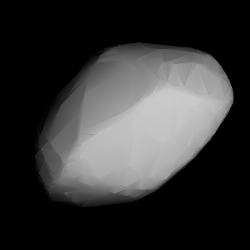
749 Malzovia is a stony background asteroid from the inner regions of the asteroid belt, approximately 11 kilometers in diameter. It was discovered on 5 April 1913, by Russian astronomer Sergey Belyavsky at the Simeiz Observatory on the Crimean peninsula. The elongated S-type asteroid has a rotation period of 5.9 hours. It was named after Russian amateur astronomer Nikolai Maltsov who founded the discovering Simeïs Observatory in 1900.
1143 Odysseus, provisional designation 1930 BH, is a large Jupiter trojan located in the Greek camp of Jupiter's orbit. It was discovered on 28 January 1930, by German astronomer Karl Reinmuth at the Heidelberg Observatory in southwest Germany, and later named after Odysseus, the legendary hero from Greek mythology. The dark D-type asteroid has a rotation period of 10.1 hours. With a diameter of approximately 125 kilometers, it is among the 10 largest Jovian trojans.
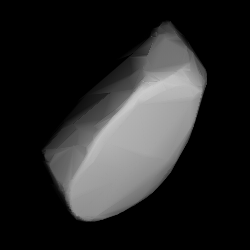
1219 Britta, provisional designation 1932 CJ, is a stony background asteroid from the inner regions of the asteroid belt, approximately 11 kilometers in diameter. It was discovered on 6 February 1932, by German astronomer Max Wolf at the Heidelberg-Königstuhl State Observatory in southern Germany. The likely elongated S-type asteroid has a rotation period of 5.57 hours. Any reference of its name to a person is unknown.
1180 Rita, provisional designation 1931 GE, is a dark and spheroidal Hildian asteroid from the outermost regions of the asteroid belt, approximately 97 kilometers in diameter. It was discovered on 9 April 1931, by German astronomer Karl Reinmuth at the Heidelberg Observatory in southwest Germany. Any reference of its later name, Rita, is unknown.
1168 Brandia, provisional designation 1930 QA, is a stony Eunomian asteroid from the central regions of the asteroid belt, approximately 10 kilometers in diameter. Discovered by astronomer Eugène Delporte at Uccle Observatory in 1930, the asteroid was later named after mathematician Eugène Brand.

1437 Diomedes is a large Jupiter trojan from the Greek camp, approximately 150 kilometers in diameter. It was discovered on 3 August 1937, by astronomer Karl Reinmuth at the Heidelberg-Königstuhl State Observatory in southwest Germany. The dark D/P-type asteroid belongs to the largest Jupiter trojans and has a notably elongated shape and a longer than average rotation period of 24.49 hours. Diomedes was the first Jupiter trojan successfully observed during an occultation event of star. It was named after the hero Diomedes from Greek mythology.
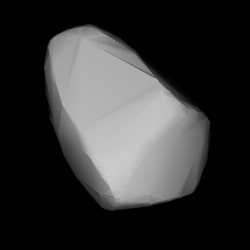
1173 Anchises is an unusually elongated Jupiter Trojan from the Trojan camp, approximately 124 kilometers in diameter. It was discovered on 17 October 1930, by German astronomer Karl Reinmuth at the Heidelberg Observatory in southwest Germany, and was the 9th such body to be discovered. The primitive P-type asteroid belongs to the largest Jupiter trojans, has an unusually smooth surface texture, the lowest spectral slope of all members of the Trojan camp, and a rotation period of 11.6 hours. It was named after Anchises from Greek mythology.

1665 Gaby, provisional designation 1930 DQ, is a stony asteroid and a relatively slow rotator from the inner regions of the asteroid belt, approximately 11 kilometers in diameter. It was discovered on 27 February 1930, by German astronomer Karl Reinmuth at Heidelberg Observatory in southern Germany. It was later named after Gaby Reinmuth, the discoverer's daughter-in-law.
2895 Memnon is a dark Jupiter trojan from the Trojan camp, approximately 56 kilometers in diameter. It was discovered on 10 January 1981, by American astronomer Norman Thomas at Lowell's Anderson Mesa Station near Flagstaff, Arizona, in the United States. The assumed C-type asteroid has a rotation period of 7.5 hours and belongs to the 80 largest Jupiter trojans. It was named after King Memnon from Greek mythology.

3451 Mentor is a large Jupiter trojan from the Trojan camp, approximately 120 kilometers in diameter. It was discovered on 19 April 1984, by Czech astronomer Antonín Mrkos at the Kleť Observatory in the Czech Republic. The uncommon Jovian X-type asteroid is one of the largest Jupiter trojans and has a rotation period of 7.7 hours. It was named after Mentor from Greek mythology. Mentor, a man who was rich in horse at Pedaeus. He was the father of the spearman Imbrius, an ally of the Trojans.

1389 Onnie, provisional designation 1935 SS1, is a stony Koronian asteroid from the outer region of the asteroid belt, approximately 13 kilometers in diameter. It was discovered on 28 September 1935, by Dutch astronomer Hendrik van Gent at Leiden Southern Station, annex to the Johannesburg Observatory in South Africa.

1902 Shaposhnikov is a dark Hilda asteroid from the outermost region of the asteroid belt, approximately 92 kilometers in diameter. It was discovered on 18 April 1972, by Russian astronomer Tamara Smirnova at the Crimean Astrophysical Observatory in Nauchnyj, on the Crimean peninsula. The asteroid was named after Soviet astronomer and WWII casualty Vladimir Shaposhnikov. It was one of the last larger asteroids discovered in the main belt.















